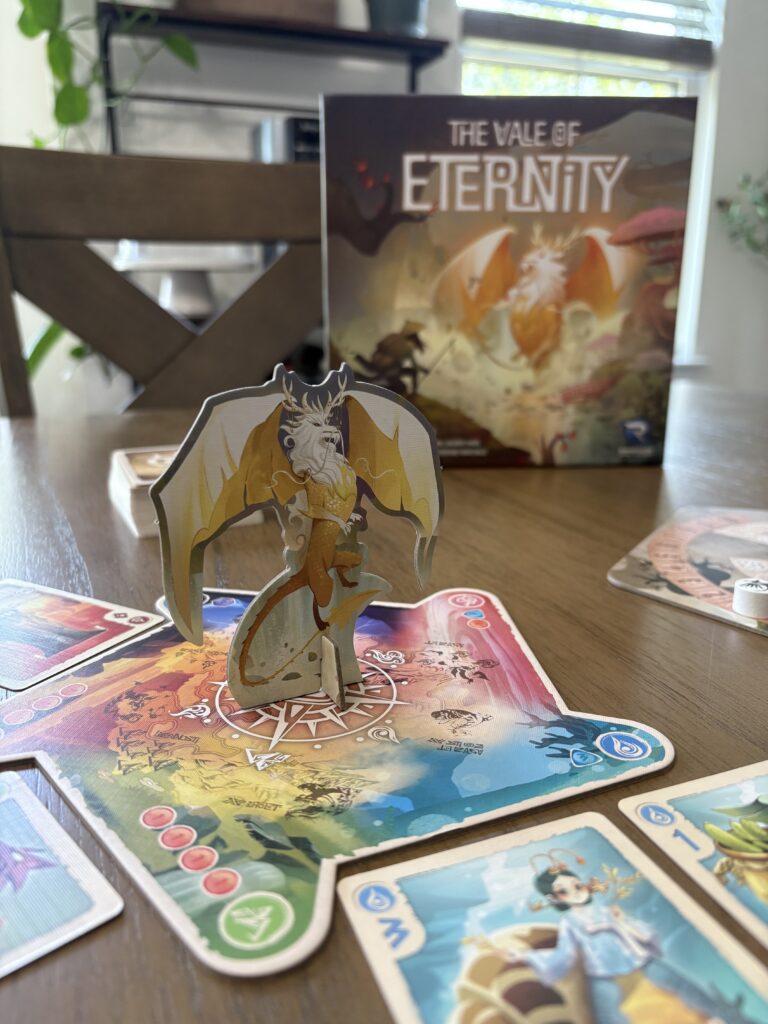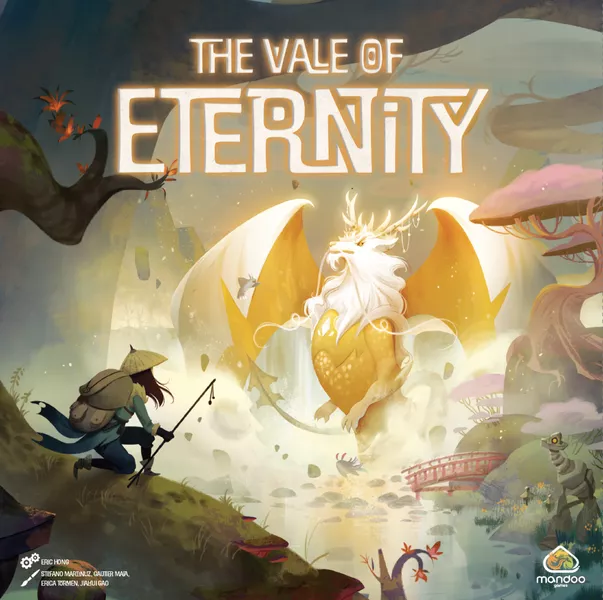Welcome to this week’s review! This week I’m discussing a small, card-drafting, tableau-building game with an extremely cute aesthetic. So without further ado, let’s jump into my thoughts.
The Vale of Eternity
- Designer: Eric Hong
- Publisher: Mandoo Games
- Complexity: Light-Medium
- Time: 30-45 Minutes
- Players: 2-4
- Main Mechanisms: Card Drafting, Tableau Building
I didn’t know much about The Vale of Eternity prior to jumping in, and I was pleasantly surprised by how relatively simple the rules are to learn, while still providing enough tactical decision-making to want to come back.

The game is loosely themed around taming and summoning creatures to build out your personal tableau. The game is played over the course of a number of rounds, and the game either ends when someone reaches 60 points or when the end of ten rounds is reached. In practice, I found the game typically lasted anywhere between eight to ten rounds which totaled to around 30-45 minutes.
Each round is divided into three phases. The first phase, Hunting, is composed of a snake draft where players take turns claiming cards from a central display. In the second phase, Action, players choose to sell the cards they claimed during the Hunting phase to receive magic stones (effectively currency), which they spend to summon cards to their personal tableau, add cards claimed to their hand, and/or summon cards from their hand. Finally, in the last phase, Resolution, players will activate any end-of-round effects from any of their cards in their display.
First off, I found that drafting and summoning cards offered a lot of interesting tactical decisions. One fascinating mechanism is that players are limited to only four magic stones at any one time, and the stones come in three different denominations. Also, you are never allowed to freely exchange or create change for your magic stones. For example, if a card costs a value of two to play, and I use a stone worth three, I do not receive a stone back with a value of one.
In addition, the cards are divided into five different families, and each type has a different value when sold. The cards themselves offer a mix of instant abilities, round end abilities, and permanent effects, such as score two points each time you summon a card of a specific type, when summoned.
Also, players are only able to sell cards they claimed during the Hunting phase and before they enter their hand. This led to many hard decisions to determine keeping the card to eventually summon, or exchanging the card for magic stones to play another more pressing card. This also plays into deciding which cards to draft and when (e.g., either drafting them to immediately sell or to summon at some other point).

Even with all of this, my favorite part of the game are the card combos you can create. If you’re someone that enjoys building up an engine of cards, then I can imagine this game is right up your alley. While some of the card abilities are similar, each of the five families of cards offer different synergies to create. For example, the water family cards tend to focus on ways to exchange magic stones, such as trading a three value for a six value, rewarding victory points when spending a card with a certain type of magic stone, or even changing the value of all of your three-valued stones to six and vice versa. On the other hand, the fire family has a lot of cheaper valued cards and generate a lot of one-valued stones.
Another interesting design decision is that players are restricted on the number of cards in their tableau, which is equal to the current round number (i.e., each player can only have up to one summoned card in round 1). And, if you want to remove a card from your tableau, you have to spend the same cost as you did to summon the card. Some of the cards can be quite expensive, and if they only offer an instant effect, that means they are just taking up space that can’t be used to play more cards. I found that I had to figure out the best time to play these more expensive cards while not clogging up my display.
Overall, there are some really cool combos you can build. For example, in one game, I didn’t summon a single card until the final couple of rounds because I built a combo which allowed me to score points based on the number of cards in my hand. While the deck of cards isn’t crazy large, I think there’s enough variety to offer plenty of replayability with different strategies.
Moving onto a few caveats, not all of the cards feel entirely balanced, and once my wife and I had played the game a few times, there were definitely moments when a strong card would come out that was an automatic grab. This leads into the next point; since the cards are selected using a snake-draft mechanism, which automatically rotates each round, there can be rounds where a perfect card for your strategy might come out, but someone else might get first pick due to chance.
Similar to the above, there is an element of luck of the draw. For example, maybe I start an early combo focusing on water cards, but then no other water card appears for the next few rounds. I can imagine if you play the game enough times, you’ll start to understand more about the deck and be able to figure out which handful of cards combo together really well. Overall, I like the level of tactical decision making in the game, but one player might get lucky that a few cards they picked up early, excellently combo with cards in later rounds.

Overall, these minor complaints don’t significantly impact my enjoyment of the game. Because the game is relatively short, even if you feel you had poor card draw luck in one game, a second game won’t take that long to play. Vale of Eternity fits nicely into a category of games that offer enough interesting decision making for fans of medium to heavy games, in a significantly smaller package that makes it also an excellent choice as a gateway or gateway+ game.
With that, I’ll wrap up this week’s review! If you’ve played Vale of Eternity, I’d love to hear your thoughts on the game, and do you have any other similar games that you enjoy? I’d love to hear your thoughts on any of the games I’ve mentioned or future content suggestions in the comments below. Happy gaming!
If you liked this post and want to be notified when new content is released, then follow me on Instagram @themeepledigest.
